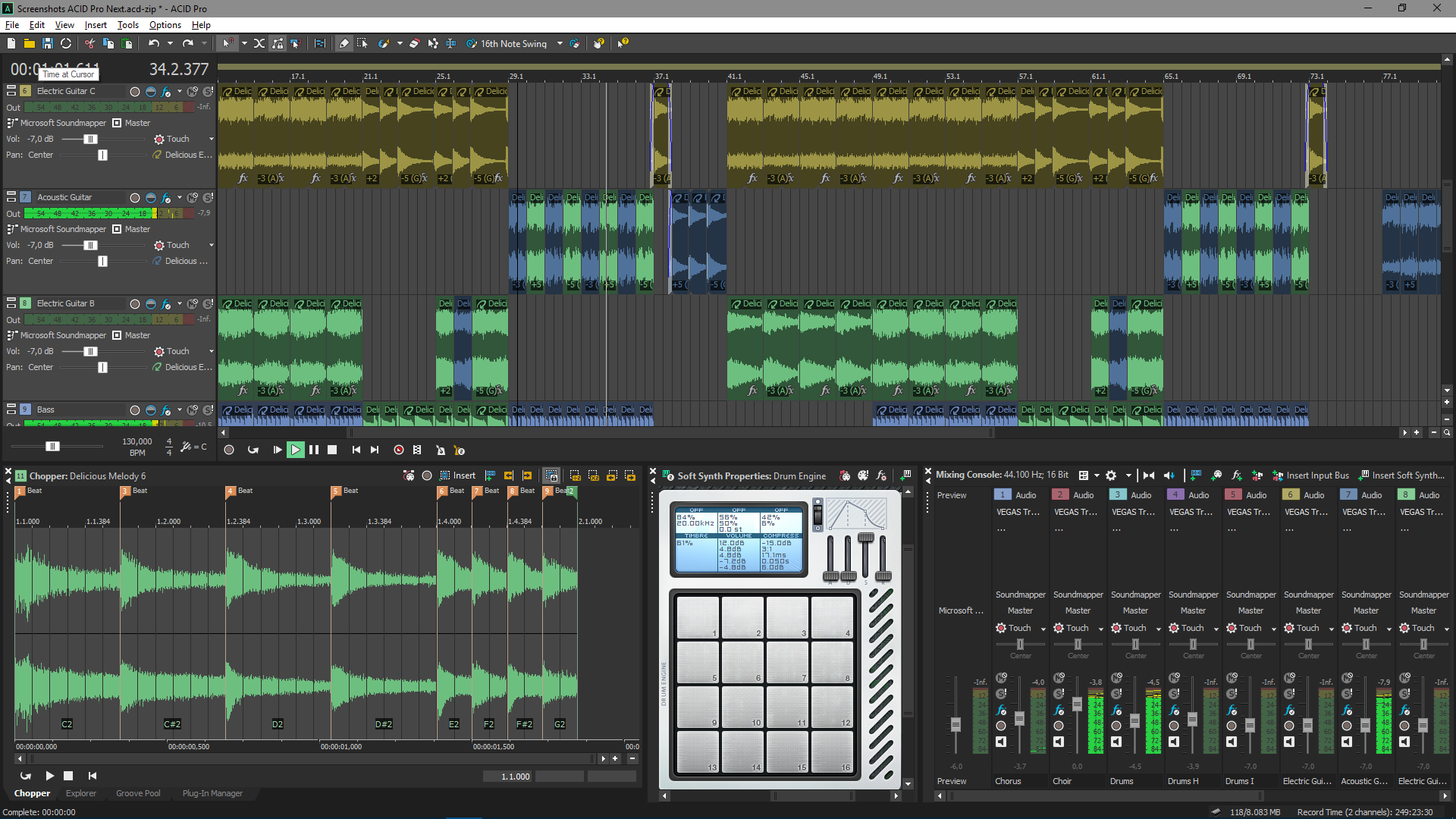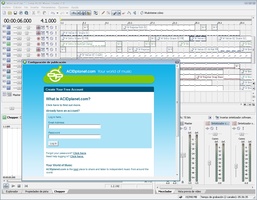DBMS is the management of data that should remain integrated when any changes are done in it. It is because if the integrity of the data is affected, whole data will get disturbed and corrupted. Therefore, to maintain the integrity of the data, there are four properties described in the database management system, which are known as the ACID properties. The ACID properties are meant for the transaction that goes through a different group of tasks, and there we come to see the role of the ACID properties.
In this section, we will learn and understand about the ACID properties. We will learn what these properties stand for and what does each property is used for. We will also understand the ACID properties with the help of some examples.
Download Acid apk 1.5.4 for Android. Realtime emulation of a Roland TB303 synthesizer and TR808 drum machine. Folic acid helps your body produce and maintain new cells, and also helps prevent changes to DNA that may lead to cancer. As a medication, folic acid is used to treat folic acid deficiency and certain types of anemia (lack of red blood cells) caused by folic acid deficiency. Final Cut Pro features improved performance and efficiency on Mac computers with the M1 chip. Rendering a complex timeline is up to 6 times faster 3 and editors can expect amazing playback performance — two streams of 4K ProRes on the MacBook Air 4 and one stream of 8K ProRes on the 13-inch MacBook Pro 5, all at full quality. ACID Properties in DBMS. DBMS is the management of data that should remain integrated when any changes are done in it. It is because if the integrity of the data is affected, whole data will get disturbed and corrupted. Therefore, to maintain the integrity of the data, there are four properties described in the database management system, which.
ACID Properties
The expansion of the term ACID defines for:
Daily iPhone app: Genius Scan. Take a picture of a document or drawing & send as JPG or PDF! Perfect to save whiteboard brainstorms. (Free) Sherry Da Costa. Pro tip: if you need a scanner or to fax something but don’t have the right printer, you can download “Genius Fax” and “Genius Scan” which takes photos, turns them.
1) Atomicity: The term atomicity defines that the data remains atomic. It means if any operation is performed on the data, either it should be performed or executed completely or should not be executed at all. It further means that the operation should not break in between or execute partially. In the case of executing operations on the transaction, the operation should be completely executed and not partially.

Example: If Remo has account A having $30 in his account from which he wishes to send $10 to Sheero's account, which is B. In account B, a sum of $ 100 is already present. When $10 will be transferred to account B, the sum will become $110. Now, there will be two operations that will take place. One is the amount of $10 that Remo wants to transfer will be debited from his account A, and the same amount will get credited to account B, i.e., into Sheero's account. Now, what happens - the first operation of debit executes successfully, but the credit operation, however, fails. Thus, in Remo's account A, the value becomes $20, and to that of Sheero's account, it remains $100 as it was previously present.

Acid Pro Software Android
In the above diagram, it can be seen that after crediting $10, the amount is still $100 in account B. So, it is not an atomic transaction.
The below image shows that both debit and credit operations are done successfully. Thus the transaction is atomic.
Thus, when the amount loses atomicity, then in the bank systems, this becomes a huge issue, and so the atomicity is the main focus in the bank systems.
2) Consistency: The word consistency means that the value should remain preserved always. In DBMS, the integrity of the data should be maintained, which means if a change in the database is made, it should remain preserved always. In the case of transactions, the integrity of the data is very essential so that the database remains consistent before and after the transaction. The data should always be correct.

Download Acid Pro For Android
Example:
In the above figure, there are three accounts, A, B, and C, where A is making a transaction T one by one to both B & C. There are two operations that take place, i.e., Debit and Credit. Account A firstly debits $50 to account B, and the amount in account A is read $300 by B before the transaction. After the successful transaction T, the available amount in B becomes $150. Now, A debits $20 to account C, and that time, the value read by C is $250 (that is correct as a debit of $50 has been successfully done to B). The debit and credit operation from account A to C has been done successfully. We can see that the transaction is done successfully, and the value is also read correctly. Thus, the data is consistent. In case the value read by B and C is $300, which means that data is inconsistent because when the debit operation executes, it will not be consistent.
4) Isolation: The term 'isolation' means separation. In DBMS, Isolation is the property of a database where no data should affect the other one and may occur concurrently. In short, the operation on one database should begin when the operation on the first database gets complete. It means if two operations are being performed on two different databases, they may not affect the value of one another. In the case of transactions, when two or more transactions occur simultaneously, the consistency should remain maintained. Any changes that occur in any particular transaction will not be seen by other transactions until the change is not committed in the memory.
Example: If two operations are concurrently running on two different accounts, then the value of both accounts should not get affected. The value should remain persistent. As you can see in the below diagram, account A is making T1 and T2 transactions to account B and C, but both are executing independently without affecting each other. It is known as Isolation.
4) Durability: Durability ensures the permanency of something. In DBMS, the term durability ensures that the data after the successful execution of the operation becomes permanent in the database. The durability of the data should be so perfect that even if the system fails or leads to a crash, the database still survives. However, if gets lost, it becomes the responsibility of the recovery manager for ensuring the durability of the database. For committing the values, the COMMIT command must be used every time we make changes.
Therefore, the ACID property of DBMS plays a vital role in maintaining the consistency and availability of data in the database.
Thus, it was a precise introduction of ACID properties in DBMS. We have discussed these properties in the transaction section also.
This topic will help you set up a MIDI keyboard for recording in ACID.
Before starting ACID, connect your MIDI device.
If you’re using a USB keyboard, connect it to an available USB port on your computer and install drivers if necessary.
If you’re using an external MIDI interface (such as a USB-to-MIDI converter or an external sound card with MIDI ports), connect the MIDI In port on your MIDI interface to the MIDI Out port on your keyboard, and connect the MIDI Out port on your MIDI interface to the MIDI In port on your keyboard.
If you’re using a MIDI cable connected to the joystick port on your sound card, connect the connect the MIDI In plug on the cable to the MIDI Out port on your keyboard, and connect the MIDI In plug to the MIDI Out port on your keyboard.
Start ACID.
Enable the port where your MIDI keyboard is connected:
From the Options menu, choose Preferences.
In the Make these devices available for MIDI input box, select the check box for the port where your MIDI device is connected.
If you want to type a name to identify the device that is connected to the port, double-click the Device box and type a new name to identify the MIDI device connected to each MIDI input or output port. For MIDI tracks that use these input and output ports, these device names will be used on the MIDI Input and MIDI Output buttons on the track header.
Select the Auto MIDI input routing check box. When this check box is selected, the focus track will accept input from any MIDI input device when you record MIDI.
When multiple tracks are selected, the focus track displays a blinking indicator in its track number: .Add a software synthesizer (soft synth) to your project. The soft synth will give a voice to the notes you play on your keyboard:

From the Insert menu, choose Soft Synth to add a soft synth bus control to the Mixing Console window (you can also click the Insert Soft Synth button in the Mixing Console window). The Soft Synth Chooser dialog is displayed.
On the Soft Synths tab, select the synthesizer you want to use, and then click OK. If you want to change your choice later, you can edit the soft synth.
Select the MIDI track you want to record into, or press Ctrl+Alt+Q to add a new, blank MIDI track to your project.
Choose a MIDI input and output port for your track:
Click the MIDI Input button on the track header and choose an input port from the menu. For this example, we can choose either Auto Input or the port you selected in step 3b above.
Click the MIDI Input button on the track header and ensure Send MIDI Input Thru to MIDI Output is selected so you can hear the notes you play while recording.
Click the MIDI Output button on the track header and choose the soft synth or MIDI device and channel you want to use to play MIDI data on the track.
Select the Arm for Record button on the track where you want to record. Arming a track enables it for recording.
Click the Record button on the transport bar to start recording.
MIDI messages from your controller are recorded as you play them.
Notes are added to an event in the timeline.
MIDI controller adjustments (such as pitch wheel and modulation wheel movements) are recorded as track envelopes. MIDI controllers are recorded in latch mode: envelope points are created when you change a control setting, and recording continues until you stop playback. When you stop adjusting the control, the control’s current setting overwrites the existing envelope points.
To stop recording, click the Record button again or click the Stop button on the transport bar.
For more information about recording from a MIDI device, please see Recording MIDI.